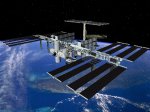ISS radiation shielding not as good as hoped
Posted: Thu, Oct 24, 2002, 9:04 AM ET (1304 GMT)
 Upgraded radiation shielding on the International Space Station is not working as well as expected, New Scientist reported Wednesday. According to the report, radiation levels within the station are about one millisievert per day, about the same amount of radiation one would get on the ground from natural sources in one year. Those levels are within a few percent of those measured on Mir despite the use of new shielding on the station designed to lower radiation levels. The primary source of the radiation is the collision of cosmic rays with aluminum atoms in the hull, creating a shower of particles. The new shielding uses polyethylene, whose lighter atomic nuclei were designed to reduce the amount of secondary particles released in collisions. Experts told New Scientist that a whole new type of shielding may be required for future missions beyond the Earth's protective magnetosphere, which shields the ISS of high-speed particles from the Sun.
Upgraded radiation shielding on the International Space Station is not working as well as expected, New Scientist reported Wednesday. According to the report, radiation levels within the station are about one millisievert per day, about the same amount of radiation one would get on the ground from natural sources in one year. Those levels are within a few percent of those measured on Mir despite the use of new shielding on the station designed to lower radiation levels. The primary source of the radiation is the collision of cosmic rays with aluminum atoms in the hull, creating a shower of particles. The new shielding uses polyethylene, whose lighter atomic nuclei were designed to reduce the amount of secondary particles released in collisions. Experts told New Scientist that a whole new type of shielding may be required for future missions beyond the Earth's protective magnetosphere, which shields the ISS of high-speed particles from the Sun.
 Upgraded radiation shielding on the International Space Station is not working as well as expected, New Scientist reported Wednesday. According to the report, radiation levels within the station are about one millisievert per day, about the same amount of radiation one would get on the ground from natural sources in one year. Those levels are within a few percent of those measured on Mir despite the use of new shielding on the station designed to lower radiation levels. The primary source of the radiation is the collision of cosmic rays with aluminum atoms in the hull, creating a shower of particles. The new shielding uses polyethylene, whose lighter atomic nuclei were designed to reduce the amount of secondary particles released in collisions. Experts told New Scientist that a whole new type of shielding may be required for future missions beyond the Earth's protective magnetosphere, which shields the ISS of high-speed particles from the Sun.
Upgraded radiation shielding on the International Space Station is not working as well as expected, New Scientist reported Wednesday. According to the report, radiation levels within the station are about one millisievert per day, about the same amount of radiation one would get on the ground from natural sources in one year. Those levels are within a few percent of those measured on Mir despite the use of new shielding on the station designed to lower radiation levels. The primary source of the radiation is the collision of cosmic rays with aluminum atoms in the hull, creating a shower of particles. The new shielding uses polyethylene, whose lighter atomic nuclei were designed to reduce the amount of secondary particles released in collisions. Experts told New Scientist that a whole new type of shielding may be required for future missions beyond the Earth's protective magnetosphere, which shields the ISS of high-speed particles from the Sun.
Related Links:
| <<previous article | next article>> |
|
news in brief
|
|
Roscosmos replaces cosmonaut on next Crew Dragon mission to ISS
Posted: Sat, Dec 6 9:45 AM ET (1445 GMT) |
|
news links
|
|
Friday, December 19
A Starlink satellite seems to have exploded
The Verge — 6:52 am ET (1152 GMT) ESA Assesses Underfunding Impact On Human, Robotic Exploration
Aviation Week — 6:51 am ET (1151 GMT) Hubble sees asteroids colliding around nearby star
ESA — 6:50 am ET (1150 GMT) A first in space autonomy
ESA — 6:50 am ET (1150 GMT) The 30-year journey of European satellite navigation
ESA — 6:50 am ET (1150 GMT) |